Archives
August 2023 saw the long-awaited return of Toothfest. Oliver Liyou and his team at EVDS normally run this globally recognised event every 5 years, but Covid delayed the 2021 event. All we can say is delayed anticipation made this year even sweeter!
This was a truly international, cutting-edge event. Not only did speakers fly into Australia from all corners of the globe, so did delegates. We were thrilled to meet people from as far afield as the UK, North America, South Africa and Norway.
We were also thrilled with how much there was to learn, and it led us to think about how the veterinary industry has changed over time. Once upon a time, most vets were in mixed practices and handled almost everything within their own practice. Now, there’s a tendency to be much more specialised. While student vets study a little of everything as part of their university course, many of them won’t do any kind of dental work at all after graduation. Vets in mixed practices and urban practices may see very few horses for any kind of work, so lack of experience means they refer issues to a specialist nearby. Even vets working in an equine practice may miss out on treating dental problems.
For attendees with this background, Toothfest was a chance to gain knowledge, experience and confidence, not just in dentistry but also in closely related areas such as general mouth and sinus health. For those with a more specialist dental background, there was plenty of advanced learning and discussion.
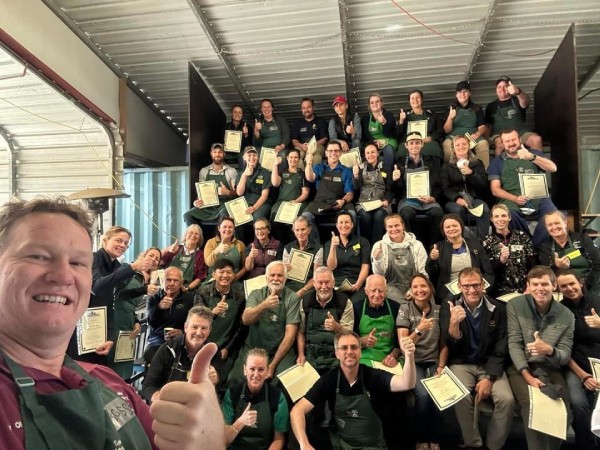
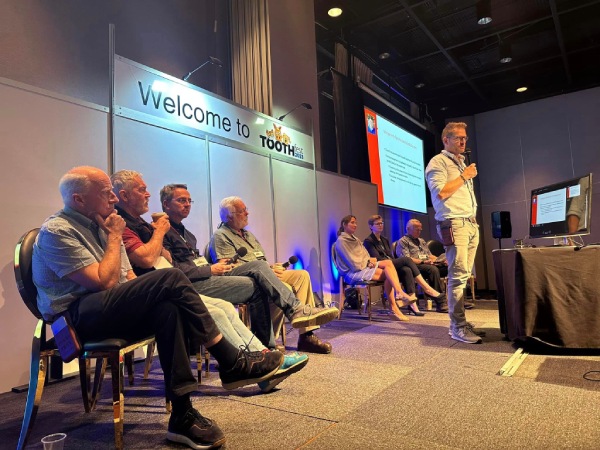
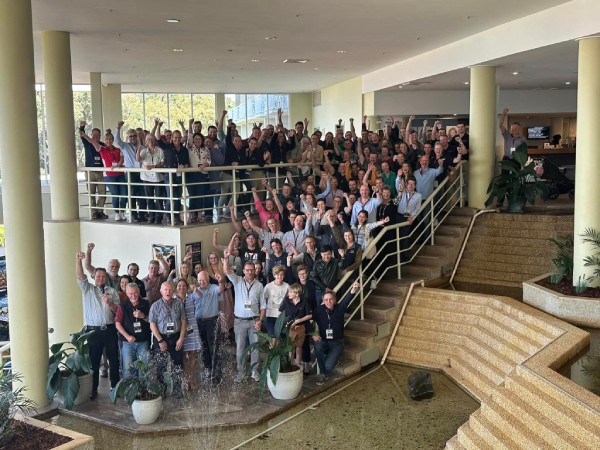
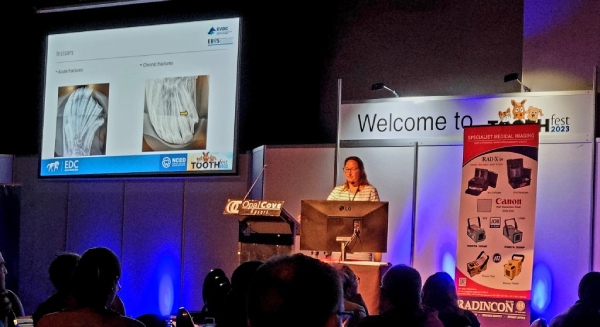
As major sponsors of this learning event, we also had a stand with all our equipment on display. Here’s the Radincon team – from left to right: Jon Marriott, Charles Spicer-Jenkins, Seb Wensing.
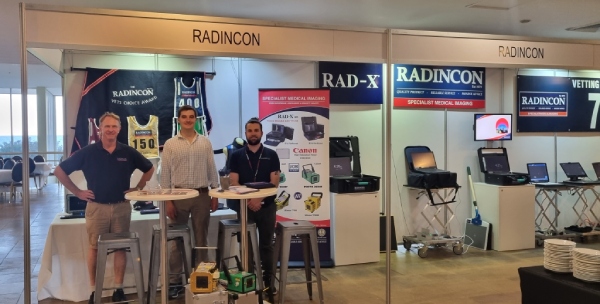
All of us extend our heartfelt thanks to Oliver, his team and all the presenters who made this event such a success. The entire speaker panel was fabulous, but we have a few special mentions to
Of course it wasn’t all serious learning. No really good event is.
Here are a few of the more lighthearted and relaxed moments.
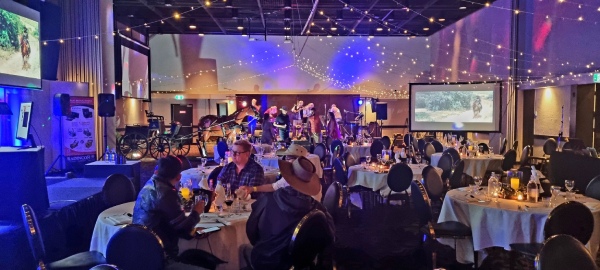
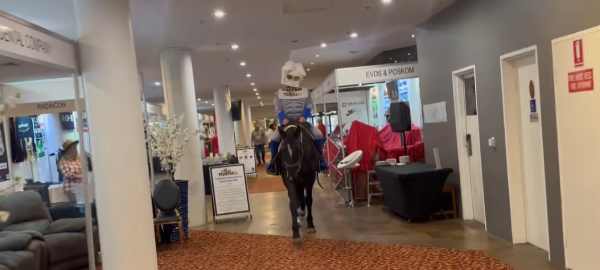
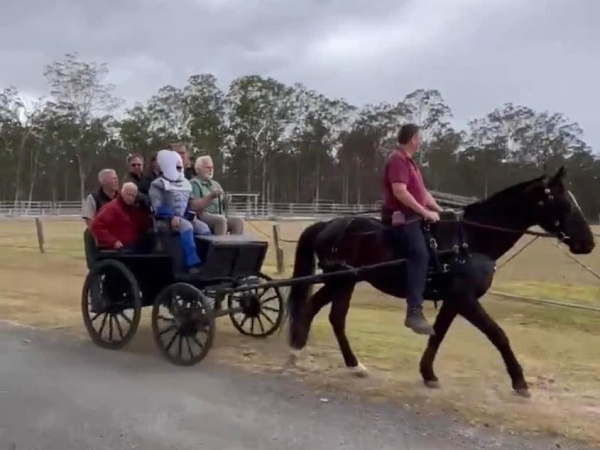
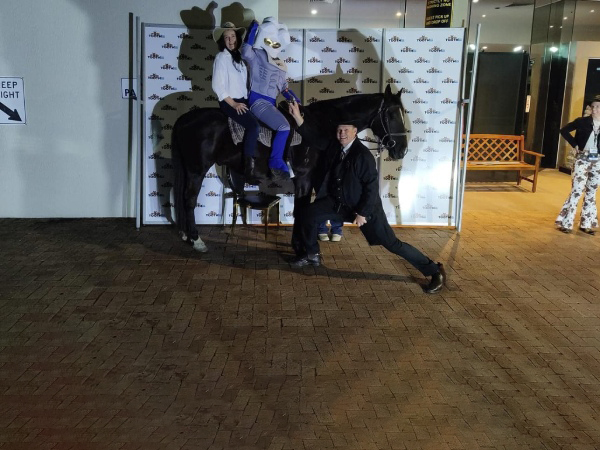
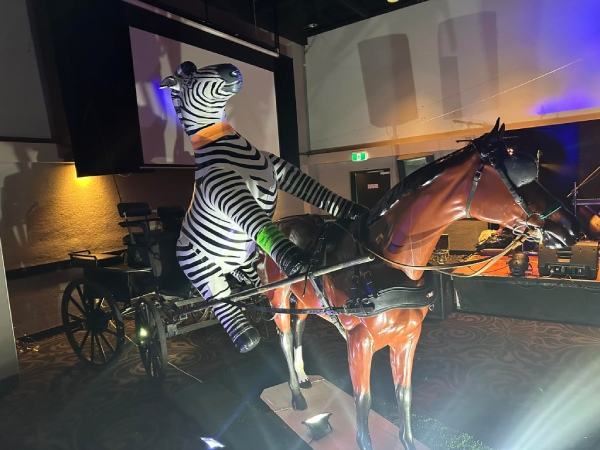
See you all again at the next one. Hoping it will only be 5 years this time!
Doctor Oliver Liyou founded Equine Veterinary Dental Services (EVDS) and has been training vets and horse owners on how to look after equine teeth ever since. We’re proud to have supported Ollie by providing the imaging equipment he needs for practical hands-on training.
We’ve provided equipment for (and attended) many courses, we have especially fond memories of the EVDS Equine Dentistry Level 1 course in June 2023. As always, there was plenty of laughter and good humour along with the learning.
One funny thing about equine dentistry is that you don’t always need a live patient to practice! All the same, we think Buffy is far cuter than any of those horse skulls, and we’d rather work with him any day! Luckily Brontë Fisher of Darling Downs Vets was able to give him a clean bill of dental health.
Skulls and Shetland ponies are a fixture at most EVDS events, but this particular course included an additional surprise element. Somehow the talk turned to poetry, and some keen people rose to the challenge.
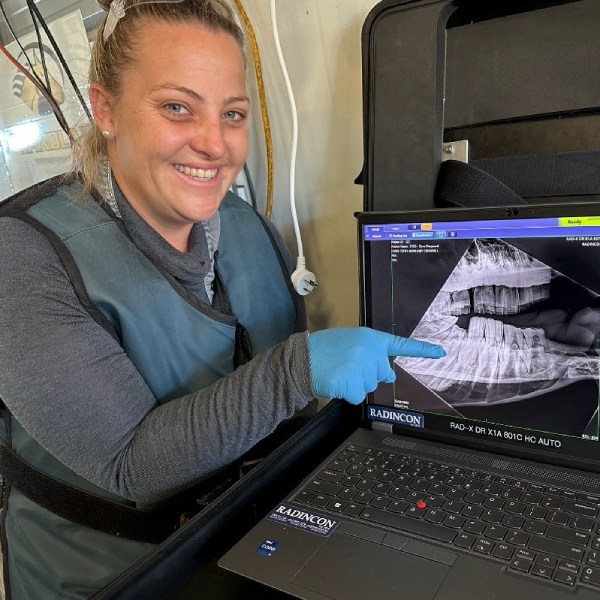

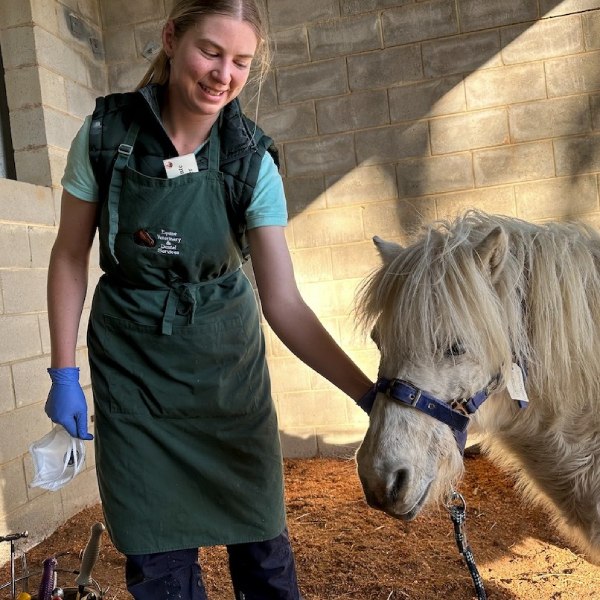
First off, here’s a poem by Paige Ludbury of Heartlands Veterinary Hospital, in the Avon Valley in WA.
Dear team of fabulous sponsors,
This an ode to your sponsorship,
Without it my equine dentistry would surely be shit. (Pardon the French).
And the scales would sure be tipped, away from the vets,
Into the hands of the lay dentist.
And oh what would become of the humble horse,
As it rears and snorts and cavorts,
From the lack of butorph.
As a hook is left, to tear a cheek
And a return to head tossing within a week.
So dear sponsors,
From a grateful vet, I thank you for contribution,
From which I can provide a resolution,
To the malocclusions and contusions,
To the humble and amazing horse.
Not to be outdone, Alex from 4cyte responded in kind!
Oh Paige, your words have touched my soul,
A poetic symphony that made me whole.
With grace and beauty, you penned your verse,
A heartfelt gratitude, I can’t rehearse.
Your poem, a melody of gratitude and praise,
For 4CYTE’s partnership in those equine dental days.
You painted images with words so fine,
Each line like a brushstroke, divine.
In the realm of dentistry, equine and grand,
Our sponsorship became a helping hand.
Together we embraced a noble cause,
Caring for horses’ teeth, obeying nature’s laws.
Your verse danced upon the page,
Enchanting readers, like a poet sage.
With gratitude, I now reply,
A heartfelt thanks, I cannot deny.
For your poem, a gift so rare,
An ode to our partnership, beyond compare.
In your words, I found solace and delight,
A testament to our bond, shining bright.
So, dear Paige, I extend my appreciation,
For your poetic creation, a true sensation.
Our journey continues, hand in hand,
Spreading smiles across the equine land.
This is the kind of community connection we love. It makes attending these events worth the plane flights and early morning drives.
It all goes to show there’s more to EVDS events than scoring a hat, although hats are exactly what these lucky winners got for the best radiograph of the day.
To put it another way:
Just take a little quiet time
The next time you’re apprenticed
To Ollie the equine dentist.
Scribble down some words that rhyme.
Almost before you know it
You’ll abandon teeth and jaws
And bow to rapturous applause
As Australia’s best horse poet.
We’re looking forward to Toothfest next week!
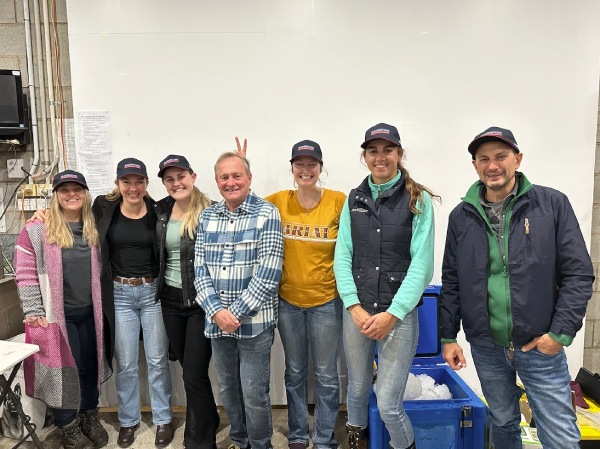
A few of our featured vets have spent time in the UK as locums. This month we’re turning that round and talking to a UK-qualified vet who came to Australia for 6 months. A couple of decades later, she’s still here.
Let’s find out more about Paula Williams of Westvets.
I was a farmer’s daughter in Sussex, in the south of England. I remember when I was young we had 6 or 7 vet students visiting for the lambing season, and I thought it was pretty cool. Then of course there were the James Herriott books, and Black Beauty. I was horse mad as a girl. So with all that in my background, I studied veterinary science at Liverpool University, and by my 3rd year I knew I wanted to be an equine vet. I’ve been caring for horses ever since, plus a few small ruminants including sheep and alpacas.
When I qualified, I worked in the University for a while, then as an intern at Rossdale’s in Newmarket, the largest equine veterinary practice in the UK. I moved to a practice in the Cotswolds, but then in 2001 the UK was hit by a foot and mouth outbreak. Restrictions on animal movements made things tough and I decided to spend a season in Australia. Somehow that season still hasn’t finished!
I started off in Western Australia, but soon ended up in Queensland, working for the Oakey Vet Hospital, then at Samford Vet Hospital, and since 2017 I’ve been at WestVETS.
I think I first met Jon while I was working at Samford, although they didn’t use his equipment. Then since I moved to WestVETS I’ve been using Radincon X-ray equipment. We have five of them here, I think. I’m an ANZCVS member in Large Animal Radiology, so I love good X-ray equipment.
Right now, though, my best mate when it comes to vet toys is our new GE Versana ultrasound. I’d wanted one for some time and it finally arrived a few months back – now I have to fight the other vets to get use of it. The image quality is just so much better than we had before, although I’ve been a vet so long I remember ultrasounds that looked like snowstorms.
I remember old-school X-ray plates too, when we had to take them back to the dark room to develop. Things are so much better with modern equipment, even if I do still end up standing a calf on blocks so I can fit the X-ray plates underneath it.
Scuba gets his name from one of my passions – scuba diving. I live about an hour from the ocean and try to get there once a month or so, but what I really enjoy are the overseas I dived in a really remote part of the Solomon Islands recently, and on my next trip back to the UK to visit my family, I’m planning a side excursion to Italy for more diving.
I love live music. I used to play, but now I just go and listen.
Apart from that, I’m involved with Equine Veterinarians Australia in an executive role. You could say that’s work-related, but equine vets are my tribe. As I said, I’ve always been horse-mad!

More of what I’m doing!
I love the imaging work and want to continue that further. I work on all kinds of musculoskeletal issues, with equines which range from performance horses to ponies. I love that variety and I love expanding my knowledge.
That’s tough.
For me, being a vet is a vocation, not a job. It can be difficult to get the work-life balance right. That makes it really important to keep the networking going and make sure you maintain friendships in the industry.
You need to make sure you always have a ‘phone-a-friend’ number in your back pocket. And make sure you use it, whether it’s to discuss a case; to have someone act as a sounding board, or simply to have a chat with someone who knows what your life’s like.
Having those people around you makes all the difference.



The Tom Quilty Gold Cup 2023, held on Saturday June 24 at Stirling’s Crossing, Imbil, Queensland, was the high point of the Australian endurance riding calendar. It was a high point for the whole Radincon team.
As a company, we were involved in so many ways.
Here’s what the Quilty looked like from our perspective.
Let’s start with the most important part of all: the mobile vet hospital, set up on site to give immediate attention to any horses requiring it.
Radincon’s sponsorship included supplying all the imaging equipment needed for the hospital, namely
plus all the accessories to make everything work together.
Radincon MD Jon Marriott drove our equipment up to Imbil from Sydney himself. Look at that spectacular sky as he arrived!
The hospital was also equipped with blood work machines (haematology and biochemistry) and a point of care machine to assess for infection. The vet team were well set up to manage any horse health problems which arose.
The race was divided into five legs, all starting and finishing at the central location. The setup allowed vets to check every horse at the end of every leg for

With over 30,000km of riding happening in just the one day (188 horses over a 160km course), we were expecting a few injuries.
13-year-old Jess the Border Collie, vet hospital mascot, moved out whenever horses came in needing treatment. Luckily that turned out to be for just a handful of minor issues rather than anything serious. All the same, we were glad to be overprepared than underprepared!
An event like this wouldn’t be possible without the vets who attend. Care for the health and wellbeing of the horses is at the heart of endurance riding – that’s why there are vet checks after every leg.
Our heartfelt thanks to all the vets who traveled from across Australia and around the world to be a part of the Tom Quilty Gold Cup 2023. A special shout-out to Head Vet Harry Weaver, who led the team with utmost expertise and passion, but we appreciate the commitment of each and every vet who cared for our equine athletes.

| Senior Vet Team | Divisional Association Line Vets | |
|---|---|---|
| Harry Weaver, Head Vet | Chris Dowey | Alex Chick |
| Lachlan Cameron, 2IC | Paul Lubbe | Laoise Ni Tuama |
| David Nolan, Treatment Vet | Sue Martin | Rebecca Wasmund |
| Sara Rodes, On Course Vet | Helen Spencer | Matthew Walker |
| Bruno Ros, On Course Vet | Anne Barnes | Rebecca Wasmund |
| David Nolan, Treatment Vet | Sue Martin | Darien Feary |
| Line Vets: | Georgia Ladmore | |
| Nick Page (New Zealand) | Rhys Powell | |
| Mike Tomlinson (USA) | Laura Salisbury | |
| Prawit Butudom (Thailand) | ||
| Katie Pantlin | ||
The low level of injury at the Tom Quilty Gold Cup 2023 is a credit to the care the riders take of their horses, not just on the course itself but in the long weeks of preparation.
Congratulations to Ashley Cole, riding Tonki Dee Boo Novak, who completed the course in just 8 hours, 44 minutes and 54 seconds. Amazing.
We’re thrilled that both Susan Woodward and Kaitlyn Mercieca earned a coveted Tom Quilty Gold Cup 2023 buckle by completing the course!
Kaitlyn and her mare Henley Farm Burosh crossed the line with a time of 12 hours 33 minutes. Susan, guiding Brookleigh Matisse around her first 100 mile ride, took 13 hours 46 minutes to finish, achieving 25th place.
Kaitlyn and Henley Farm Burosh at pre-ride vetting




What impressed Head Vet Harry Weaver and his team about Aimee Jeffrey, so much that they awarded her The Radincon Vets Choice Award?
It was her obviously close relationship with her mount, Die Kinder Kosmonaut. Kozzi is a 9-year-old partbred Arabian who didn’t want to have his temperature taken during vet checks. However, while he certainly has a mind of his own, Aimee was able to coax him into compliance – keeping an eye out for the welfare of the vets at the same time!
This connection between horse and rider, along with respect for the vets and others who make the event possible, is truly in the spirit of the award. Congratulations to Aimee and Kozzi.

Let’s finish this wrap-up with some fun.
For the Tom Quilty Gold Cup, the vetting process is ‘Vet Gate into Hold’ rather than traditional vetting. With the clock still ticking until the rider and horse scan into the vetting area, locations close to the in gate are prime strapping spots. Every year teams of strappers line up and then race to secure the best spot they can. It’s a few moments of craziness, usually with a few collisions. (This year those collisions included our sponsored rider Susan Woodward, who tripped over one of the Team Kurrajong strappers.) Enjoy the video.
Congratulations are also due to the Stirling’s Crossing team who organised such a successful event.
We at Radincon had plenty on our plates, but the organisers had far more.
Next year’s Tom Quilty Gold Cup will be held in Wirrina, South Australia. Despite the effort involved, we’re looking forward to it already!
Can you remember the title of any of your high school text books? Dr Peter Prendergast of Collaroy Vet Hospital can. Our featured vet for June claims his year 12 biology textbook ‘The Web of Life’ solidified his lifelong fascination with how living things work, and was one factor in his becoming a vet.
I was always fascinated by the diversity of life – and amazed that something so complicated doesn’t go wrong more often. So I loved biology and the life sciences. It was a choice between veterinary science and medicine really. One of my older brothers did medicine, so you could say I’m a copycat. Then again, as the youngest of seven kids, I was likely to copy at least one of my siblings fairly closely.
I’m a Sydneysider through and through. I was born in Annandale and I studied at Sydney University. Like so many young Australian vets, I did my time as a locum in English vet practices, but by 1997 I was back here and linked up with two other vets to buy an existing practice on the Northern Beaches. There were lots of semi-rural properties in the area back then, so we looked after a fair number of horses at the start. Over time that’s shifted so that most of our work now is with small animals.
In 2009 the partnership dissolved and I’ve been the sole owner of Collaroy Vet Hospital ever since. It’s the longest I’ve ever held one job. I have a great team of around 15 people including vets, nurses and admin. Not everyone’s full-time, but between us we run the practice 7 days a week.

As a vet I’ve always been passionate about getting the diagnosis right. It’s like working out a puzzle so you can help animals and their owners, so you can be of service. I’m still fascinated by science and spend hours watching science videos on YouTube. I love all the continuing education we do as vets too. Not only do I learn useful stuff to help my patients, those trips to Melbourne or Brisbane are like mini-holidays.
The practice had X-ray equipment from Radincon when we took over, so it feels like I known Jon Marriott for ever. I remember right at the start it was all manual processing with chemicals and developer. Then we moved on to an autoprocessor, and then to digital X-ray. Radincon have always been there for us – not just Jon, but Alex and the rest of the team too. We’ve never even thought of going anywhere else. And of course they’re close by so it’s easy to pop in and pick something up if we need to.
Like so many vets, I spend a lot of time at work – in fact my kids complain about it. They’ll say, ‘Mum says you care more about guinea pigs than you do about us!’
When I do have time off, I love to be active – cycling, kayaking and so on. I used to do amateur drama and I’d love to get back into that soon.
I’d say there’s two main things to remember.
First, try and make a diagnosis yourself. Don’t assume that because you don’t have the experience, you can’t do it. There’s an old saying: You miss more by not looking than you do by not knowing. So take a look and make a diagnosis instead of always going to a specialist.
Second, don’t rush your appointments. Take the time you need – and that means time for the client in the room as well as the patient. That’s how you build relationships and grow your practice. A physical examination doesn’t take long, but if you talk to the client, you’ll learn that the dog always panics at the vet’s, so you don’t have to worry about the salivating or the panting. Don’t just talk about the pet, either. Asking about other things – family, holidays and so on – helps you build relationships and build trust, so you’ll have fewer issues later on.
The ANZCVS and Radincon have a long history of working together. We caught up with the current ANZCVS CEO Stephen Alderman to hear their perspective on the relationship.
The Australian and New Zealand College of Veterinary Scientists is a certifying body. We prepare and administer examinations in many areas of advanced veterinary practice. That could be focusing on a specific animal, such as equine vets, or it could be a discipline like radiology.
While any vet can join the AVA, to become a member of the ANZCVS, you have to pass the relevant examinations. That gives you the right to become a member and use the postnominals after your name. Their expertise means our members are often found in referral centres for general vet practices in their geographic area. So deep knowledge and experience is available when needed.
In Australia and New Zealand we have one organisation which manages advanced certifications across all veterinary subjects. Globally, we’re unusual – most countries have institutions which focus on a particular discipline or subject area. We get a lot of overseas vets taking our certifications, and they make up 10-20% of our membership.
As for me, I joined the ANZCVS two weeks before COVID. It was terrible timing. Almost the first thing I had to do was to shut down the Vet Science Week conference and all examinations for the year, something that had not happened since the College was founded in 1971.
We all knew it was time to implementing a digital business model. I just don’t think any of us were planning to do it quite so quickly!
The main work of the ANZCVS is setting and administering examinations. A typical examination includes two written papers and an oral examination. There are also practical examinations – so for example radiology candidates have to review radiology studies and report on their findings.
Before COVID, all the examinations were held at Science Week every year. You had to fly in to sit them in person. We’d have 250-300 candidates, plus another 140 or so examiners, all flying into the Gold Coast at that same time. The written examinations were all paper-based; orals were face-to-face. We also needed specific equipment and so on for practical examinations. Radincon has been involved since at least 2017, providing DICOM viewers for all the radiology candidates. We’d know how many candidates we had with a radiology practical, so we’d work out how many viewers we needed. Right from the start, Radincon has been able to provide whatever number of viewers we requested, and has shipped them to and from the Gold Coast at their own expense.
Then, with COVID, we couldn’t have everyone at the Gold Coast. People couldn’t leave their states.
The easiest part was moving oral examinations online. The technology was straightforward and there was no issue with integrity since two examiners and an invigilator were on every call. But for integrity reasons, we still needed to supervise written and practical examinations. So we set up different examination centres for each state. That meant more equipment, more logistics and more shipping cost, but Radincon stepped up and supported us through those very difficult years.
COVID forced us to digitise quickly, and to decentralise. We’ve moved away from the idea that everyone has to come to the Gold Coast. The long-term plan is to have remote proctoring. We’re testing that this year, but we’re not relying on it just yet.
In the meantime, we’ll have locations in the individual states of Australia. It’s less distance to travel, and also easier if you’re juggling a busy life, not just at your practice but also with family and personal commitments.
For our overseas candidates, they have an opportunity to nominate an invigilator. Clearly, we have to approve that person, but then they can take the examination locally. We’ve got someone in Mumbai, India this year.
For practical exams, we’re implementing the Radincon RocketPACS solution for the first time this year. It will be much easier logistically. Instead of shipping equipment around the country, all we need is connection to the internet and licences to use the software. Nor will there be hours spent loading images onto all the viewers. We just upload them once to the cloud and they’re available anywhere.
Candidates bring their own device and log onto our locked down examination platform. There will also be a second device available to log on to RocketPACS. (To avoid any disputes or concerns around image quality, we’ve worked with Radincon to identify the minimum display requirements.) There’s no need to annotate into RocketPACS – candidates can easily view studies across all modalities and access a rich set of DICOM Viewer tools provided on the RocketPACS platform to answer the examination questions. They enter all the answers on their own device.
RocketPACS is intuitive and many practices use it already, so some candidates may have experience with it already. We have created RocketPACS walk-through videos for all the candidates. Online familiarisation sessions are also offered for anyone that would like one. The Radincon support team has also offered to assist our examiners and candidates if they require in-depth knowledge of any particular feature.
One candidate from Singapore is sitting a radiology examination. In the past, that would have meant flying into the Gold Coast, or during COVID we could have shipped equipment internationally. Now all we need to do is provide access to a device with a modern web browser, a high-quality screen in Singapore and test the internet speed.
In 2023, we’re using RocketPACS for radiology only. We’re not expecting any issues, but limiting the number of candidates this first year makes sense. We have discussed that in the future we might extend usage to other subjects. We may also find some chapters which haven’t traditionally run a practical examination consider it now that the logistics are easier.
We’re grateful to Radincon for all the support we’ve received over the years. There are plenty of free online DICOM viewers, but we’re running professional examinations. We need something commercial grade, with commercial quality support so that if something happens we can get help straight away. That would be really hard to get elsewhere, but Radincon have always been there for us.
It’s all about the professionalism of the exams. Radincon have made it so easy and always at no charge. When I think about how much it must have cost over the years, I want to express the gratitude of everyone at ANZCVS.
We’re heading interstate and off the mainland this month to meet our featured vet, Chris Cornes of Longford Equine Clinic in Tasmania. But that trip’s nothing compared to the traveling Chris has done in his life.
Here’s what he has to tell us about his travels, his practice and his thoughts on being a vet today.
Growing up on a farm, I loved being outdoors and I liked animals, so I guess studying to be a vet was a natural progression. My family moved to Western Australia about the time I reached university age, and Murdoch University had just started offering a veterinary science degree, so I enrolled there. I was part of the second cohort of vets to graduate from Murdoch – just 34 of us! Things are very different today.
After graduation I worked in a practice in WA, dealing primarily with cattle, which was only to be expected given my farm background. I found I was testing thousands of cattle for pregnancy in the days before ultrasound, when it really was a hands-on (hands-in?) process! For some reason it didn’t take long before I was bored, so I quit and headed off to the UK in search of adventure.
I worked as a locum across England and Scotland. It was pretty different work, being mostly pets rather than cow after cow all day. My time at Dingwall in Scotland stands out – the people were so welcoming. They offered me a permanent position and I was tempted, but in the end I decided I couldn’t handle the climate.
By the time I came back to Australia in 1987, I’d had enough of mixed practice. I wanted to specialise in one species rather than knowing a little bit about everything. I settled on horses (no more cows, thanks very much!) and have been working in equine practices ever since. I’ve been in Tasmania for nearly 30 years now. It can get chilly here, but it’s still warmer than Scotland!
Longford Equine’s a specialist equine practice, very close to Longford Racecourse. We attend meetings there to keep an eye on all the racehorses.
Caring for mares during stud season is obviously very important to our business, but we also do a lot of athletic work. We attend the thoroughbred trials at Longford, and the races at Launceston. We also go to the standardbred races at Carrick and Launceston.
We don’t just work with racehorses either! We have all kinds of equines as patients. That includes miniature donkeys – one of our clients breeds them and they’re cute and charming little animals.
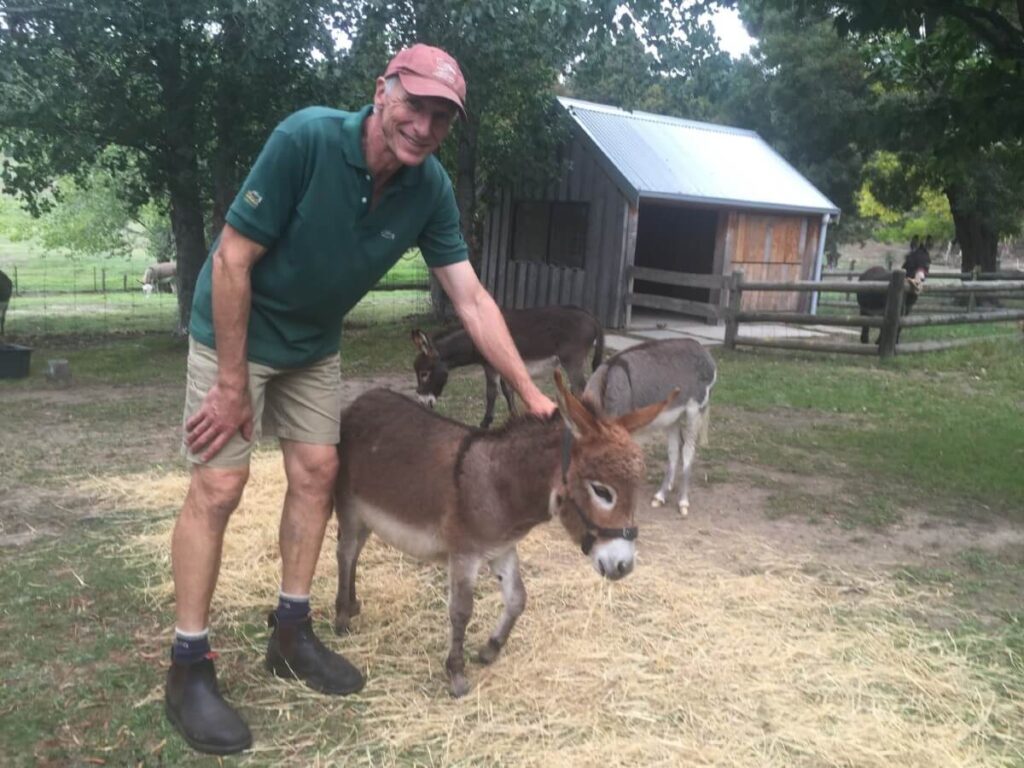
I joined the practice in 1999. We used to have 4 vets but have dropped to two. Finding staff is a challenge. We’ve been advertising for two years without success. At this stage of my life, I’d ideally like to work 2-3 days a week, but with only two of us that’s not possible. Being on call every other night is a bit much too. As we told the ABC recently, if we can’t find at least one more vet we’ll probably have to close the Clinic. It’s ironic given Australia’s training so many more vets now than it used to, but it seems to be a problem everywhere.
Longford Equine Clinic got our first digital X-ray equipment from Radincon nearly 15 years ago. It’s an Eklin device; we still have it; it still works. It’s given us far less trouble than the wireless one we bought from someone else more recently. So Jon (Marriott) is right when he says quality’s worth the extra price over the long term.
We catch up regularly with the Radincon team – they supply our gloves, aprons and so on. It’s always good to have a chat.
Unless we find a vet to join us soon, we’ll be closing the practice. I’ve been thinking about what I might do next and I’d like to work part-time in some way related to local wildlife. That could be part of a scientific study, or possibly assisting with conservation. It’s something to explore.
Now that’s a big question! As I already said, things are so different now!
First up, it’s hard to get vets these days, so you’re in a position of power. If you find you’re unhappy somewhere, don’t stick around suffering in silence. Sort it out or move on. You’ll find another role.
On the other hand, you have to accept that some parts of the job will be rough and to look after yourself. That includes mental toughness. It’s hard when you can’t save someone’s beloved pet and they blame you. Or when you’re on call in the evenings and can’t go out with your friends.
So make sure you leave your work at work when you do have time off. And try to schedule some regular activity which helps you get away from the practice and from being a vet. For example, I play tennis on Friday afternoons – not every Friday, but almost every Friday. We have to be really under the pump for me to give that up. It’s how I keep going. I also do a lot of Bikram yoga (hot yoga) which is really helpful physically and mentally.
Oh, one final thing. Make sure your clients pay you! Most will, but don’t let the tricksy ones get away with it.
***
Thank you Chris Cornes of Longford Equine for taking time out to talk to us.
We have a special interest in your practice, since you look after Fizz, a beautiful little Arab who paired up with Radincon sponsored rider Susan Woodward for her first 160km endurance ride in 2022. Any vets out there interested in caring for horses great and small, get in touch with Longford Equine now!
If we can’t magic a vet into existence to keep the practice going, at least we know you’ll still be working with animals, helping out the local wildlife.
Top quality equipment like the ultrasound and X-ray systems we provide at Radincon are great value, but they’re still major investments which you need to plan for. Tax incentives like the Instant Asset Write-Off can make that investment less of a strain on your pocket.
We sought advice from industry finance expert John Rowe of Veterinary Finance Australia, who has extensive long-term experience working with vet practices at every level of maturity. John has helped many of our customers finance purchases, so they keep more cash in the business and can grow faster. We love his strategic approach.
Usually, when you buy capital assets, your accountant will depreciate them over the ATO-approved lifetime of the asset. In your accounts, you spread the cost over many years, and each year, you get a tax deduction based on a portion of the cost.
The Instant Asset Write-Off lets you depreciate the whole value of the asset in the first year. It was introduced in October 2020 to support businesses during COVID.
What does this mean for you and your practice? Quite simply, you pay less tax in the year that you buy the equipment. Every cent of the purchase prices comes straight off your tax bill and you get to keep that cash in your practice and use it for other purposes. That could be paying off loans faster, or you might want to invest in business areas such as marketing, staff or training.
An additional benefit is that it makes depreciation compliance far less complex, for you, your accountant or your bookkeeper.
If you’re looking to upgrade or add to your imaging capability, this was made for you. The best and latest equipment will not only give you productivity gains, it’s a powerful way to retain and attract members of your team.
The Instant Asset Write-Off was due to expire at midnight on 30 June 2023, but the Federal Budget delivered on May 9, 2023 has extended that till the same time in 2024. There are however a few changes – notably the introduction of a $20,000 limit on the value of any individual piece of equipment.
Here’s a comparison with the differences shown in red.
Capital equipment (assets) which you purchase and install before 30 June 2023.
Capital equipment (assets) which you purchase and install between 1 July 2023 and 30 June 2024.
From 1 July 2024 onwards, the current expectation is that we will revert to traditional depreciation methods, with instant asset write-off only applicable to assets (equipment) worth less than $1000.
Could your practice benefit from new equipment? Should you leverage the Instant Asset Write-Off and financing to support cashflow? Now’s the time to find out. Here’s what you’ll need to do:
Hats off to Equine Veterinarians Australia for organising and delivering another fantastic set of EVA state meetings in March and early April 2023. The team at Radincon were delighted to sponsor and support, and it was really worthwhile attending and catching up with equine vets to get the local news.
It was a jam-packed schedule with four events on consecutive nights across the country. Of course, that was no problem for the attendees in each state, but it was certainly busy for the organisers and for Professor Susan Stover, who spoke at all meetings except Tasmania. Lots of hotels, planes and driving on her whirlwind tour of Australia.
Radincon MD Jon Marriott didn’t quite make every dinner, but he did attend in Queensland, South Australia, Victoria and of course New South Wales. (He drew the line at WA, not because of the distance, but because it would have meant missing his youngest daughter’s 17th birthday. Seriously bad timing!)
Given the number of client visits and other work Jon also had to fit in, he was relieved to be back in his home state for the last EVA state meeting on April 4th. By that time he and Susan Stover had really got to know each other, as you can see from the photo.


Susan’s presentation at the events covered the diagnosis, treatment and prevention of musculoskeletal injuries. Based at the JD Wheat Veterinary Orthopedic Research Laboratory in California, she is currently researching how different training regimes can be used to minimise the risk of such injuries, and everyone was interested to get her insights. There were also plenty of questions from the floor too, which extended the learning even further.
There were some wonderful venues too, from the historic British Hotel in Adelaide (founded in 1838 and still going strong) to the modern setup of the auditorium at the Inglis Oaklands Complex in Victoria. Every state served up its own special mix of food, wine and intelligent company.


All in all, this was a brilliant series of events which will help vets all over Australia care for horses as well as possible.
Let’s finish with a shout out to some of our longstanding partners, clients and above all friends in the Australian equine veterinary community. The EVA state meetings are always a great chance for us all to catch up with each other as well as extend our knowledge. We look forward to many more years working and learning with you.
This month we’re in Mudgee, NSW. The area’s famed for gourmet food and wine, but the people are also warm and welcoming. That includes our April featured vet, David Parry-Okeden of Church Street Vets, Mudgee.
Here’s what he had to tell us about his career, his life and his thoughts on being a vet.
I always wanted to be a vet. I grew up on Warwick Farm Racecourse in south western Sydney, surrounded by space and all the domestic and farm animals. I recall sitting on the racetrack fence, and watching that inimitable jockey, Billy Cook riding trackwork on Australia’s greatest horse of the time (perhaps of all time), Carioca.
I never thought of doing anything other than working with animals. My only fear was that I might not get the marks to study as a vet, but I was lucky again and I was accepted into university. Thank goodness it was easier in those days!
I graduated from Sydney University in 1968 and headed out to the country to be a rural vet. I’ve been one ever since.
Church Street Vets is a mixed practice, looking after animals small and large in Mudgee and the surrounding area. We have 4 vets, all of us working 3-4 days a week and all with different interests. I personally love the large animals, especially horses, but with a range of vets there’s always someone who can help. There is still a position for another vet to join our practice.
We became interested in digital radiography right at the beginning, in the early 2000s. We could see it being used in the human field and realised the advantages for us. Jim Woods, who’s now part of the Radincon team, was then working at AGFA. We spent a lot of time working with him, adapting human algorithms to images from my son’s ponies – but then we hit a snag. The quality of the images was amazing but the equipment was the size of a very large fridge and there was no way we could truck it over rough country roads to all the farms and studs. It was clear to us that CR was not suitable and that DR was the obvious way to go.
Research into the overseas companies providing digital veterinary equipment led us to California on a field trip. We ended up choosing a system from Eklin (their first export sale), and brought the unit back in our baggage allowance. The hardest part of the whole process was getting it lifted off the conveyer belt at Brisbane Airport – the union rep told us it was too heavy for anyone to lift and we couldn’t have it. It weighed around 30kg, so it was possible to lift, but there were union rules. Luckily, I was able to distract the union rep long enough to lift it myself, and then we were OK to get back to the practice.
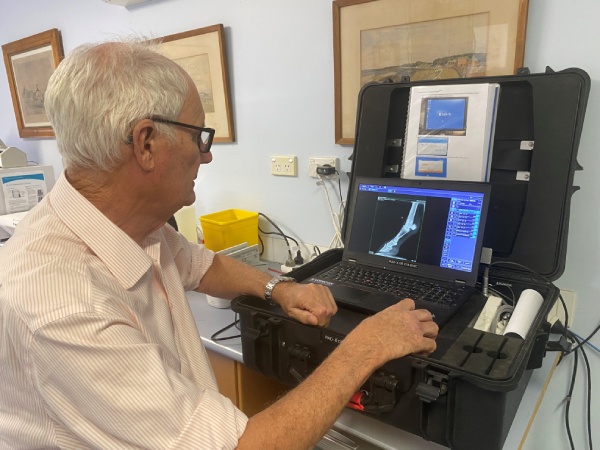
With the advent of repository x-rays at horse sales, business took off. We went into partnership with John Crowley and with initially two and later three Eklin-Canon DR machines, we were taking repository x-rays in all states. Dog breeders were impressed with the speed with which we could “develop” their hip score radiographs. Every sick or injured animal was being x-rayed, always with the owner watching. It really helped us grow the practice.
Veterinary imaging has come a long way since those days. The systems we had then wouldn’t cut it today. We’ve upgraded at every opportunity, always with Canon-based systems through Radincon.
It’s simple and straightforward.
I live with my wife, Lannie in Mudgee. We have three sons who are now all live in Sydney with their families; only 3 hours’ drive to visit. As with any country town the vets soon become part of the local community, with many of the clients and farmers becoming life-long friends. We have owned numerous animals over the years but are now down to one Jack Russell dog. We thought about having a cat, but Jack Russells and cats do not mix.
Each year we aimed to spend some of the winter months travelling outside Australia, with or without the golf clubs and taking the opportunity to see some European and American practices.
A veterinary degree has always opened a vast array of career opportunities and that certainly has not changed. Neither has the enormous satisfaction to be gained in being your own boss and doing what we do in a local community. I would encourage any young veterinarian to aspire to owning their own rural practice.
Veterinary practice has certainly changed in many ways. On balance for the better. Post-graduate education has become much more readily available. This is largely due to the initiative set up by Tom Hungerford in the 1970s. Technical advances in imaging have revolutionised many aspects of rural practice.
We had some student vets visiting Mudgee recently and I quoted them a figure for how much they could expect to earn if they worked hard and ran their own practice. They were amazed and quoted very moderate salaries that they had been told to expect. I further suggested that there were some things they should consider if they aspire to rural practice.
Thank you David Parry-Okeden for fitting this interview in around vet emergencies and the challenges of rural phone coverage! It was great talking to you and we look forward to catching up in person sometime soon.
The Australia Zoo Wildlife Hospital opened in 2004, and treats all kinds of wildlife, from birds to water snakes, koalas to possums. The dedicated staff deal with injuries from car accidents and attacks by domestic pets as well as treating infections and caring for orphans. They also look after marine life including sea snakes, turtles and more.
The country’s largest purpose-built wildlife hospital has a surgical theatre, intensive care units, its own pathology lab and an x-ray room.
Radincon has been supporting Australia Zoo since October 2020, when we supplied a RAD-X DR X1A 701C Soft Case Portable DR System.
Until recently, the X1A was used both in hospital and in field work. Taking the X-ray gear to the animal rather than moving the animal to the hospital keeps trauma to a minimum for the animal and vet team. The DR enables real-time viewing of X-rays in situ, which is a massive improvement over the previous hospital based CR cassette system. There’s no delay in seeing results, and if something is unclear a repeat shot takes 3 seconds. It’s easier for the staff, but more importantly for the animal.
Our latest installation at Australia Zoo is the supply of another DR. This one’s a RAD-X DR CX3A 702C Mobile In-Clinic System. This was installed in December 2022.
The first and most obvious improvement is that the Zoo and Wildlife Hospital now has two x-ray and DR systems, a dedicated in clinic mobile system and portable field use system.
A feature of the CX3A is the advanced viewing on a clinical review DICOM calibrated monitor. This delivers the true grey scale for more accurate viewing and diagnosis. Birds, snakes and lizards make up more than half of the Wildlife Hospital’s patients, and their fine skeletal structures demand high resolution viewing to diagnose smaller variations that can be hard to spot. It just makes sense to have a screen which can show all the information your DR system captures!
The Canon CXDI NE post processing software used on the two DRs is identical so there’s no new learning curve for staff. Great for simplicity and productivity.
While we’d love to think there would be fewer cases of injured wildlife in years to come, increasing traffic and pressure on the environment makes it unlikely. At least the Australia Zoo Wildlife Hospital is all set up to go on caring for injured wildlife for many years into the future.
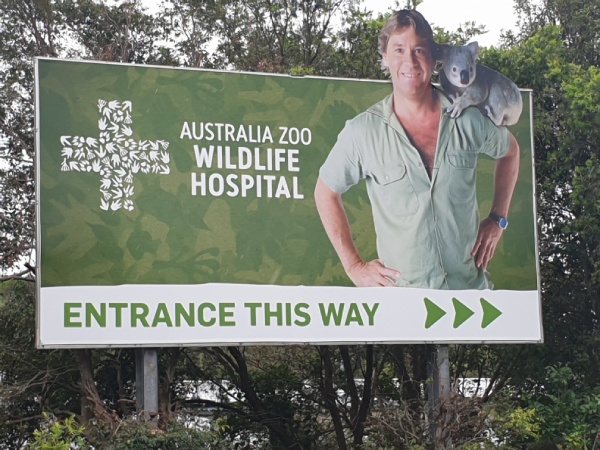
Just about every vet we’ve ever met is a dedicated, caring person who works long hours to make things better for animals of all kinds. We’d like to share the love and celebrate some of the great human beings who are part of our vet community.
This month, we’re kicking off with Kim Martel of the Yoogali Veterinary Centre in Griffith, NSW.
We caught up recently to find out a bit more about him.
I’ve been a vet for 47 years now, and I’ve been in mixed practices for most of my life.
I used to have a practice in Cootamundra, but due to injuries I sold that back in 2004. I was a part time faculty member at Charles Sturt University in Wagga Wagga for many years, but then in 2014 I felt the need for a fresh challenge, so I opened a new practice in Griffith.
Initially, that practice was called the Griffith Animal Hospital. In 2019 when we moved to a new state-of-the-art facility in neighbouring Yoogali, we also changed the name to Yoogali Veterinary Centre.
I head a team of 4 vets and 5 vet nurses, supported by our two receptionists, looking after animals from all around the area. 90% of our patients are small animals, and then there’s a mixed bag of larger animals. We treat horses, sheep, cattle, goats and alpacas. We even do a small number of exotics and zoo animals.
We look after all the day-to-day things you’d expect at a practice, with a focus on surgeries, soft tissue surgery and orthopaedics.
I love the variety. I’d get bored if it was the same every day. Most recently I operated to remove a tumour from a guinea pig. I don’t do that very often!
Yes, I do. Right now my wife and I have two cats. We used to have dogs but they need more time and attention, which we can’t provide at the moment. Our lives are busy as I still have business commitments in Cootamundra and I travel there every week.
Like I said, I get bored quickly, so I’ve always had outside interests. I’ve been a pilot for 47 years and I used to be a commercial pilot with my own air charter business. I also have a longstanding interest in computers and have written veterinary and accountant computing software.
And I play the bagpipes! I’ve been doing that even longer than I’ve been flying. Some people prefer me to fly away before I play!
These days I’m finding myself too busy. I don’t want to retire completely, but I wouldn’t mind selling the practice and working as a locum or on-call just a couple of days a week. That would give me the time to have a dog again too.
Oh, I’ve known Jon (Marriott) for donkey’s years, from back when I was in Cootamundra. I went straight to him for equipment when I set up in Griffith. We’ve got an X-ray table and machine from Radincon, plus a DR unit and an older CR unit. And we’ve been using the RocketPACs DiCOM system since last year. Love the instant X-rays and the ways it’s accessible for anyone we choose to share with, so it’s easy to collaborate.
Also I should say that although I haven’t known Alex as long as I’ve known Jon, he’s just as good. He gives fantastic support even when he’s in Japan. I love the way the whole team help out in any way they can.
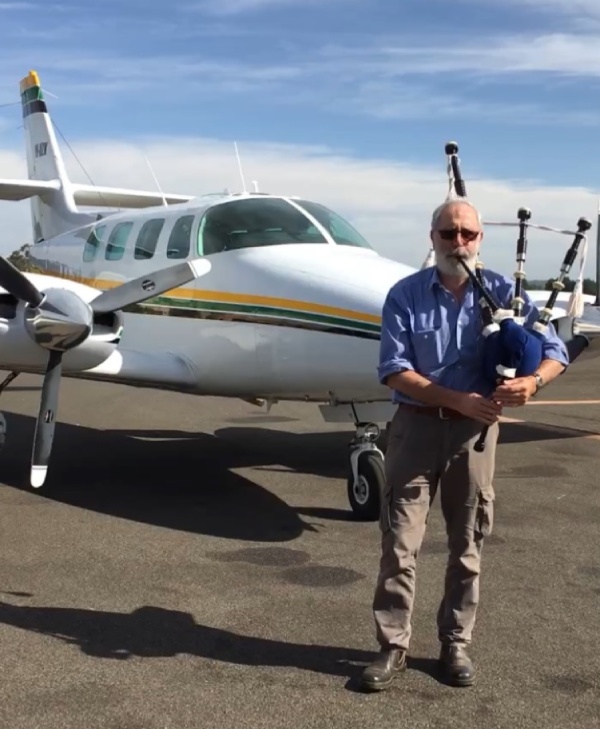
Enjoy yourself!
Work and attitudes to it are really different these days, but some things don’t change. You spend hours at work, so make sure you do something you enjoy.
And it might sound contradictory, but:
You’ll be busy, but you’ll be happy.
***
Thank you, Kim Martel, for finding time in your busy life for this interview. We hope to continue working with you as long as you continue working, whether that’s at Yoogali or as a locum somewhere in the area.